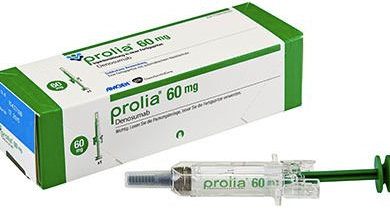
Pressmeddelande -
Amgen Receives Positive CHMP Opinion To Expand Use Of Prolia (denosumab) To Patients With Glucocorticoid-Induced Osteoporosis
THOUSAND OAKS, Calif., April 27, 2018 - Amgen (NASDAQ:AMGN) today announced that the Committee for Medicinal Products for Human Use (CHMP) of the European Medicines Agency (EMA) has adopted a positive opinion for the marketing authorization of Prolia (denosumab) for the treatment of bone loss associated with long-term systemic glucocorticoid therapy in adult patients at increased risk of fracture.
"Today's positive opinion by the CHMP is an important step for Prolia in helping patients suffering from bone loss associated with systemic glucocorticoid therapy," said Sean E. Harper, M.D., executive vice president of Research and Development at Amgen. "Chronic use of oral glucocorticoids has been associated with an increase in spine and hip fractures,1 and, if approved, an expanded use of Prolia will provide patients and physicians across much of Europewith a new treatment option for this serious condition."
Glucocorticoid medications, which are used to treat many inflammatory conditions such as chronic obstructive pulmonary disorder (COPD), asthma, multiple sclerosis and rheumatoid arthritis, can cause significant side effects, including bone loss.2,3
The CHMP recommendation is supported by a Phase 3 randomized, double-blind, double-dummy, active-controlled study evaluating the safety and efficacy of Prolia compared with risedronate in patients receiving glucocorticoid treatment.4 The study included two patient groups: those on sustained glucocorticoid therapy and those newly initiating glucocorticoid therapy. The study met the primary endpoint (percent change from baseline in lumbar spine bone mass density [BMD] at 12 months, assessing non-inferiority) and all secondary endpoints (the percent changes from baseline in lumbar spine and total hip BMD at 12 and 24 months, assessing superiority). Study results showed that, in patients on sustained glucocorticoid therapy, Prolia treatment led to greater gains in BMD, compared with risedronate, both at the lumbar spine (4.4 percent versus 2.3 percent, respectively) and total hip (2.1 percent versus 0.6 percent, respectively). Similarly, in patients newly initiating glucocorticoid therapy, Prolia treatment led to greater increases in BMD, compared with risedronate, both at the lumbar spine (3.8 percent versus 0.8 percent, respectively) and total hip (1.7 percent versus 0.2 percent, respectively).
Adverse events and serious adverse events were similar between treatment groups and consistent with the known safety profile of Prolia. No serious adverse events were reported with a subject incidence of two percent or greater in either treatment group.
The CHMP positive opinion will now be reviewed by the European Commission (EC), which has the authority to approve medicines for the European Union (EU). Norway, Iceland and Liechtenstein, as members of the European Economic Area (EEA), will take corresponding decisions based on the decision of the EC.
The U.S. Food and Drug Administration (FDA) is currently reviewing a supplemental Biologics License Application for this expanded indication and has set a Prescription Drug User Fee Act (PDUFA) action date of May 28, 2018.
About Glucocorticoid-Induced Osteoporosis (GIOP)
GIOP is the most common form of secondary osteoporosis.3 However, the proportion of patients that qualify for GIOP diagnosis and intervention is very small and depends on the level of exposure to glucocorticoid medications.5,6 In addition, a significant proportion of the patients treated long-term with glucocorticoid medications are already diagnosed with postmenopausal osteoporosis or treated with osteoporosis medications. Importantly, at similar levels of BMD, postmenopausal women taking glucocorticoids have considerably higher risk of fracture compared with nonusers of glucocorticoids.7 The most frequent chronic inflammatory diseases associated with long-term glucocorticoid use are chronic obstructive pulmonary disorder (COPD), asthma, and rheumatoid arthritis.1 More than 10 percent of patients who receive long-term glucocorticoid treatment are diagnosed with a clinical fracture, and 30 to 40 percent have radiographic evidence of vertebral fractures.8,1
About Prolia (denosumab)
Prolia is the first approved therapy that specifically targets RANK Ligand, an essential regulator of bone-removing cells (osteoclasts). Prolia is approved and marketed in over 80 countries worldwide.
Prolia is approved in the EU for the treatment of osteoporosis in postmenopausal women and in men at increased risk of fractures. In postmenopausal women Prolia significantly reduces the risk of vertebral, non-vertebral and hip fractures.
Prolia is also approved for the treatment of bone loss associated with hormone ablation in men with prostate cancer at increased risk of fractures. In men with prostate cancer receiving hormone ablation, Prolia significantly reduces the risk of vertebral fractures.
Prolia is administered as a single subcutaneous injection of 60 mg once every six months. Please see the Important Safety Information below.
EU Important EU Product Information
Calcium and Vitamin D supplementation
Adequate intake of calcium and vitamin D is important in all patients.
Precautions for use
HypocalcaemiaIt is important to identify patients at risk for hypocalcaemia. Hypocalcaemia must be corrected by adequate intake of calcium and vitamin D before initiating therapy. Clinical monitoring of calcium levels is recommended before each dose and, in patients predisposed to hypocalcaemia within two weeks after the initial dose. If any patient presents with suspected symptoms of hypocalcaemia during treatment (see section 4.8 for symptoms) calcium levels should be measured. Patients should be encouraged to report symptoms indicative of hypocalcaemia.
In the post-marketing setting, severe symptomatic hypocalcaemia has been reported (see section 4.8), with most cases occurring in the first weeks of initiating therapy, but it can occur later.
Skin infections
Patients receiving Prolia may develop skin infections (predominantly cellulitis) leading to hospitalisation (see section 4.8). Patients should be advised to seek prompt medical attention if they develop signs or symptoms of cellulitis.
Osteonecrosis of the Jaw (ONJ)ONJ has been reported rarely in patients receiving Prolia for osteoporosis (see section 4.8).
The start of treatment/new treatment course should be delayed in patients with unhealed open soft tissue lesions in the mouth. A dental examination with preventive dentistry and an individual benefit-risk assessment is recommended prior to treatment with denosumab in patients with concomitant risk factors.
The following risk factors should be considered when evaluating a patient's risk of developing ONJ:
- potency of the medicinal product that inhibits bone resorption (higher risk for highly potent compounds), route of administration (higher risk for parenteral administration) and cumulative dose of bone resorption therapy.
- cancer, co-morbid conditions (e.g. anaemia, coagulopathies, infection), smoking.
- concomitant therapies: corticosteroids, chemotherapy, angiogenesis inhibitors, radiotherapy to head and neck.
- poor oral hygiene, periodontal disease, poorly fitting dentures, history of dental disease, invasive dental procedures e.g. tooth extractions.
All patients should be encouraged to maintain good oral hygiene, receive routine dental check‑ups, and immediately report any oral symptoms such as dental mobility, pain or swelling or non-healing of sores or discharge during treatment with denosumab. While on treatment, invasive dental procedures should be performed only after careful consideration and be avoided in close proximity to Prolia administration.
The management plan of the patients who develop ONJ should be set up in close collaboration between the treating physician and a dentist or oral surgeon with expertise in ONJ. Temporary interruption of treatment should be considered until the condition resolves and contributing risk factors are mitigated where possible.
Osteonecrosis of the external auditory canalOsteonecrosis of the external auditory canal has been reported with denosumab. Possible risk factors for osteonecrosis of the external auditory canal include steroid use and chemotherapy and/or local risk factors such as infection or trauma. The possibility of osteonecrosis of the external auditory canal should be considered in patients receiving denosumab who present with ear symptoms including chronic ear infections.
Atypical fractures of the femurAtypical femoral fractures have been reported in patients receiving denosumab (see section 4.8). Atypical femoral fractures may occur with little or no trauma in the subtrochanteric and diaphyseal regions of the femur. Specific radiographic findings characterise these events. Atypical femoral fractures have also been reported in patients with certain co-morbid conditions (e.g. vitamin D deficiency, rheumatoid arthritis, hypophosphatasia) and with use of certain pharmaceutical agents (e.g. bisphosphonates, glucocorticoids, proton pump inhibitors). These events have also occurred without antiresorptive therapy. Similar fractures reported in association with bisphosphonates are often bilateral; therefore the contralateral femur should be examined in denosumab-treated patients who have sustained a femoral shaft fracture. Discontinuation of Prolia therapy in patients suspected to have an atypical femur fracture should be considered pending evaluation of the patient based on an individual benefit‑risk assessment. During denosumab treatment, patients should be advised to report new or unusual thigh, hip, or groin pain. Patients presenting with such symptoms should be evaluated for an incomplete femoral fracture.
Long-term antiresorptive treatment Long-term antiresorptive treatment (including both denosumab and bisphosphonates) may contribute to an increased risk for adverse outcomes such as osteonecrosis of the jaw and atypical femur fractures due to significant suppression of bone remodelling (see section 4.2).
Concomitant treatment with other denosumab-containing medicinal products
Patients being treated with Prolia should not be treated concomitantly with other denosumab-containing medicinal products (for prevention of skeletal related events in adults with bone metastases from solid tumours).
Renal impairmentPatients with severe renal impairment (creatinine clearance < 30 mL/min) or receiving dialysis are at greater risk of developing hypocalcaemia. The risks of developing hypocalcaemia and accompanying parathyroid hormone elevations increase with increasing degree of renal impairment. Adequate intake of calcium, vitamin D and regular monitoring of calcium is especially important in these patients, see above.
Dry natural rubber
The needle cover of the pre-filled syringe contains dry natural rubber (a derivative of latex), which may cause allergic reactions.
Warnings for excipientsThis medicinal product contains sorbitol. Patients with rare hereditary problems of fructose intolerance should not take this medicinal product.
This medicinal product contains less than 1 mmol sodium (23 mg) per 60 mg i.e. essentially 'sodium-free'.
For more information, please see the Prolia Prescribing Information, and Medication Guide.
For more information, visit www.amgen.com and follow us on www.twitter.com/amgen.
För mer information, vänligen kontakta:
Maria Eriksson Svensson, medicinsk chef, Amgen, tel: 076-1099440
1. Angeli A, Guglielmi G, Dovio A, Capelli G, de Feo D, Giannini S, et al. High prevalence of asymptomatic vertebral fractures in post-menopausal women receiving chronic glucocorticoid therapy: a cross-sectional outpatient study. Bone. 2006;39:253-9.
2. Feldstein A, et al. Practice patterns in patients at risk for glucocorticoid-induced osteoporosis. Osteoporosis Int. 2005;16:2168-2174
3. Briot K, Roux C. Glucocorticoid-induced osteoporosis. RMD Open. 2015;1:e000014.
4. Saag KG, Wagman RB, Geusens P, Adachi JD, Messina OD, Emkey R, Chapurlat R, Wang A, Pannacciulli N, Lems WF. Denosumab versus risedronate in glucocorticoid-induced osteoporosis: a multicentre, randomised, double-blind, active-controlled, double-dummy, non-inferiority study. Lancet Diabetes Endocrinol. 2018 Apr 6. pii: S2213-8587(18)30075-5. doi: 10.1016/S2213-8587(18)30075-5.
5. Buckley L, et al. Arthritis Care Res (Hoboken). 2017;69:1095–1110.
6. Lekamwasam S, et al. Osteoporos Int. 2012;23:2257-2276.
7. van Staa TP, et al. Bone density threshold and other predictors of vertebral fracture in patients receiving oral glucocorticoid therapy. Arthritis Rheum 2003;48:3224-3229.
8. Curtis J, Westfall AO, Allison J, Bijlsma JW, Freeman A, George V, et al. Population-based assessment of adverse events associated with long-term glucocorticoid use. Arthritis Rheum. 2006; 55:420-6.
Ämnen
Om Amgen
Alltsedan grundandet 1980 har Amgen varit en pionjär inom bioteknologi. Amgens strävan är att bekämpa allvarliga sjukdomar genom att ständigt expandera potentialen av biologiska läkemedel. Med utgångspunkt i en djupgående förståelse för humangenetiken och den mänskliga biologins grundläggande mekanismer söker Amgen identifiera nya viktiga signalvägar som kan ligga till grund för innovativa behandlingar för svårt sjuka individer.

